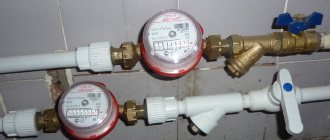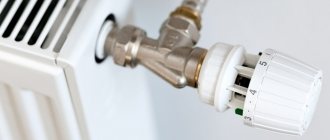assets/from_origin/upload/resize_cache/iblock/ba2/600_450_2/ba2a25e93dc7a8f98b1e466b5d5b00c5.jpg From this article you will learn:
- Who should replace the sewer system in an apartment?
- How to replace the sewer system in an apartment by housing and communal services
- What you need to know about the design of the sewage system in an apartment to successfully replace it on your own
- What are the general rules for replacing sewerage in an apartment?
- What is needed to replace the sewer system in an apartment?
- Which pipes to choose for replacing sewerage in an apartment
- How to dismantle the old sewer system in an apartment
- How to install sewer pipes and risers in an apartment
Sewage systems significantly improve the quality of life of modern people. However, old communications that have become obsolete and still function in some houses, on the contrary, can bring a lot of inconvenience to everyday life. When blockages and leaks occur, it becomes necessary to clean and replace rusted sections of pipes that have become unusable, and perhaps the sewer system as a whole. In addition, old sewerage makes excessive noise and emits a specific unpleasant odor. Finally, periodic flooding of neighbors below creates many additional problems and can lead to unplanned financial expenses, litigation, etc.
There comes a time when the need to replace the sewer system in the apartment becomes obvious. The most correct solution: having prepared the project, purchase everything you need and, after dismantling the old elements of the sewer system, install new, high-quality and wear-resistant ones.
Replacing a sewer riser in an apartment: the responsibility of housing and communal services or homeowners
The main materials from which sewer systems were previously made were cast iron (risers) and steel (plumbing communications). All these parts are subject to corrosion. Their average service life is about 25 years. Old houses are distinguished by the presence of plumbing problems. In particular, corrosion developing in pipes eventually leads to overgrowing of the lumen. In addition, in places where the inner surface of the pipe is uneven and in the area of sewer connections, cracks appear, pipes burst, and the contents flood the neighbors.
A timely decision to replace the riser and all sewer lines will help to avoid possible problems with sewerage in an old house. It is quite possible to cope with such work on your own.
In accordance with the laws of the Russian Federation, it is possible to replace sewer pipes in an apartment at the expense of the management company, although not everyone is informed about this. The procedure for repairing and replacing sewerage systems is regulated by:
- Rules for maintaining joint property in apartment buildings;
- Norms and rules for the operation of housing stock;
- Methodological recommendations for the maintenance and repair of housing stock MDK 2-04.2004.
The above documents place the responsibility for the maintenance and repair of public sewer systems on the owners of high-rise buildings. For example, risers used by several apartments of the same entrance, in accordance with the rules for maintaining common property in apartment buildings, are considered common property. While the pipes extending from the riser are plumbing communications that are maintained and repaired at the expense of the homeowners.
In addition, the branches from the riser pipe to the first connecting connection are also classified as common property.
All repairs and replacement of common property must be carried out by the management company in accordance with the agreement concluded with the property owners.
Riser pipes of all types related to sewer and water supply lines are serviced by housing and communal services management, homeowners' associations or other companies, as they belong to common property. To make a decision on carrying out repair work, the management company must receive an application from the property owners.
Recommended articles on this topic:
- Arrangement of a small apartment
- Stages of renovation in an apartment
- Turnkey cosmetic repairs
In turn, apartment owners, according to the law, are responsible for the safety and proper operation of common property. If a malfunction occurs in the sewer riser (or the need to replace it), the owner is obliged to report problems with the public sewer system. Repair work must be carried out by the management company at the expense of the owners’ financial resources. These expenses are included in the “housing maintenance and repair” section of utility bills.
Funds for replacing risers on all floors of the house are also taken from utility bills, but from the “major repairs” section.
There are times when, for certain reasons (for example, you don’t like the appearance, changing the wiring of all plumbing during an apartment renovation), the owner wants to replace a completely working riser. In this situation, he, as the owner, independently organizes and pays for all the necessary work.
In housing owned by the municipality, the risers are replaced at the expense of the owner who rents it out, that is, the municipal authorities. For residents, such work will be performed free of charge after submitting an application to the housing and communal services of the municipality.
What to do to avoid flooding your neighbors
The electricity meters in the apartment must be changed by the owners themselves, and on the landing - by the management company. Balcony repair The issue of balcony repair is controversial. After all, it partly belongs to the owner of the premises - the parapet, the roof, the canopy, and partly the housing and communal services - the protruding slab and load-bearing wall. Accordingly, what is broken is repaired by those who own it. The owner's responsibilities include: Strengthening the parapet. Replace window frames, broken glass, damaged doors. Remove rust and mold. Paint the façade and balcony ceilings with a special anti-corrosion compound. Monitor the condition of external fasteners.
How to replace the sewer system in an apartment by housing and communal services
You must first invite a plumber to diagnose the condition of the sewer riser. After the inspection, the specialist will draw up a report in which he will register defects in the sewer system and justify the need to replace specific elements. Next, an application is filled out in any form addressed to the director of the management company with an explanation of the reason and a request to repair/replace the riser.
The document is signed by the owner indicating the date of application. It is advisable to complete the application in two copies. One of them remains with the owner of the property, and the management company (the municipality's housing and communal services) puts a mark on it regarding the registration of this document.
This is what an application template for replacing a sewer riser looks like:
To avoid problems with consideration of the application, the owner of the property in Moscow must first pay off all debts on utility bills. When a decision is made on the application, a time convenient for carrying out repair work is agreed upon. The plumbing service of the management company or contractors invited by it will directly replace the riser. At the specified time, the owner is obliged to provide free access to the bathroom to replace the pipes/sewage riser in the apartment.
The actual question is, what is the cost of this work? There is no need to pay any money to replace the common building riser and the communications going from it to the first connecting point. On average, this kind of plumbing work costs 4,000–7,000 rubles.
Sometimes the management of management companies, counting on the residents’ legal illiteracy, insists that the owner of the property pay for the replacement of the riser. The rationale for this is simple: the riser is located on the territory of the owner’s apartment, which means that the latter must be responsible for all the property.
When such situations arise, it is necessary to confidently, based on the current legislation, insist that risers of all types (sewer, water supply, connected to the heating system) that ensure the functioning of several apartments belong to common property. Responsibility for their trouble-free operation, repair and replacement rests with the management company.
Difficulties with the law when doing independent repair work
There is no ban on changing the riser yourself, as such, but there are nuances. Residents are allowed to repair common property on their own using their own money, but before starting work, they will have to inform the management company that the owner wants to deal with his riser on his own, and also obtain permission from the neighbors through whose apartments communications pass. It is difficult to get permission from the management company, because the owner is often not a specialist.
If you decide to change the riser without the knowledge of the management company and other neighbors, then such an operation will be considered illegal, and the owner who carried out the secret replacement risks receiving a subpoena from his management company.
Check out other materials on our website about water supply and the problems that arise with it. Read about what standards of water quality and pressure, under what circumstances the resource can be turned off, how to pay for water according to standards and meters, what standards are without meters, as well as about the recalculation procedure and what to do if the water pressure decreases weak.
.
What you need to know about the sewage system in an apartment to replace it
It should be noted that the sewer distribution diagram does not contain anything complicated in its structure. Compared to water supply networks, sewer communications are simpler. The sewer system must ensure the transportation of water with the resulting impurities from different intake points (toilet, sinks, washing machine, bathtub, etc.) to the riser.
Let's get acquainted with the principles by which sewer networks are designed in a multi-storey building, taking into account current standards and technological rules for performing work.
To save space, old buildings built in the 60s–90s of the 20th century were typically designed taking into account the proximity of the bathroom, kitchen and toilet. Therefore, the sewer systems in these houses are very similar. The first communication node began under the kitchen sink, then the pipe passed through the bathroom and toilet and crashed into a common riser that descends through all floors.
To ensure functional reserve and ventilation capabilities of the sewer system, the riser always has access to the roof.
Such a system traditionally operates according to the following principles:
- The main function is to move water with impurities from sanitary tanks to the common house riser;
- Water flows into the riser by gravity - there is no need to create additional pressure in the system;
- To implement the above principle, the pipes are placed at a certain angle in accordance with building regulations. Then the water will be able to flow down the inclined plane into the riser without hindrance;
- The slope of the system must be adjusted throughout. If this is not observed, in places where there are narrowings or turns, impurities can accumulate, creating obstacles to the outflow of fluid.
Each of us understands that for water to pass well through the system, the slope must be at a sufficient angle from the receiving point to the discharge area. It is important to control this slope during installation and various types of repair work.
When designing a sewer system in a multi-storey building, the location of one of the lowest points in the apartment must be immediately provided - the point where the sewer outlet pipe inserts into the riser. As a rule, it is located a few centimeters from the slab, which serves as a floor between floors. To avoid problems with the operation of the sewerage system, it is necessary to correctly determine the level (height) of the location of the opposite end, that is, the upper part of the horizontal section of the pipeline. Calculation of the upper point of the sewer communication is based on two parameters:
- pipe diameter;
- total length of the sewer network.
In construction, the following standard values exist:
- the use of pipes with a diameter of 85–100 mm requires a slope of at least two percent;
- pipes of smaller diameter (approximately 40–50 mm) create the need for a greater slope - more than three percent.
Practice shows: the specific slope value for each meter of a pipe with a diameter of 50 mm will be 3 cm. For example, if the sink is located at a distance of two meters from the riser, the upper point of water drainage should be 6 cm above the entry point into the riser.
The natural question is: will the sewage system be functional if the slope of the pipes between the upper and lower points is greater than recommended? At first glance, the higher the slope angle, the potentially more effective gravity flow will work. In practice, things don't work out so smoothly. The fact is that if the sewer system brought out exclusively clean water, then the increased slope angle would definitely play a positive role.
But the sewer system was originally designed to discharge dirty water. In particular, small food fragments and fat get into kitchen communications. This dirty suspension intensively settles on the inner surface of the pipes, causing them to gradually become overgrown and impede the outflow of water.
If the sewage system did not work on the principle of self-cleaning, then it would be necessary to regularly, at least once a week, free the pipes from plaque. However, the drainage system is designed in such a way that, due to the inclination of the pipes, it is capable of mechanically washing away deposits from their surface. A necessary condition for this: water must move at the planned speed and occupy a certain percentage of the diameter of the sewer pipe. This condition helps to implement a specially calculated slope.
Attention! Effective cleaning of pipes in apartments is ensured by two options for laying them: when a slope of 2-3% is created, proportional to their diameter, or at an angle of 90˚, that is, vertically.
General rules for independently replacing water supply and sewerage pipes in an apartment
In parallel with the distribution of water supply, plumbing work is being carried out to install the sewer system and replace the riser. It should be noted that the last type of work is estimated to be the most expensive among the services of companies in this area. Occasional replacement of individual segments of the sewer system is advisable, as it avoids sudden blockages caused by a thick, greasy mass with many food particles deposited on the surface of the pipes. The sewer network in all old houses emits a specific unpleasant odor, which distinguishes it unfavorably from modern apartment buildings. Characteristic signs of an old type of sewer system are: loud flushing in the toilet and sinks, quite frequent blockages of the system, leading to flooding of neighbors. Preventive measures used by plumbers are ineffective. Here you will need to act radically and change some of the networks.
One of the plumbing units that often fail due to a large amount of sewage deposits on its surface is a cast iron tee. Blockages cause corrosion of the metal, which damages the riser - cracks develop and leaks form. This causes problems for the owner of the apartment and his neighbors living below.
Before installing a new system, sewer pipes are selected by diameter, and the slope is calculated according to the design documentation. Horizontal sections should not contain 90⁰ turns. Initially, an area is cleared in the apartment where sewer networks will be laid. Next, the specialist dismantles the worn-out, usually steel, pipes and installs new ones made of polyvinyl chloride instead. All modern houses are equipped with this type of pipes. They can be mounted in open and closed (inside walls) versions.
In a water supply system, pipes are often laid in a niche. To improve aesthetics, the niche is lined with brick or tile, and after installation it will be difficult to get to the pipes. If, however, the sewerage system cannot function normally, all surrounding structures will need to be dismantled.
After the pipes have been installed and the riser in the apartment has been replaced, the plumbing elements are connected: a corrugation is installed in the drain, previously connected to a siphon (in the sink or bathtub); The toilet corrugation is built into the riser. Risers can serve for a long time if the installation work was carried out by competent specialists who comply with current standards and regulations.
We recommend that you carefully read the video demonstrating the features of installing sewerage in an apartment:
When is it time to change the sewer riser?
The need to replace part of the riser arises in the following cases:
- A leak was detected.
- After purchasing a home in an apartment building (MCD), when the new owner decides to replace communications rather than wait for leaks to occur.
- Planned work.
In houses built in the middle and end of the 20th century, cast iron pipes were used in the construction of sewers. This material is reliable, but most of the objects were built a long time ago, and the communication networks have become old. Leaks often occur and repairs are required. It can be urgent, but most often the replacement is done as planned.
What is needed to replace the sewer system in an apartment with your own hands?
Let's consider a typical case. In the old Khrushchev-era panel building there is a common riser pipe with a diameter of 110 mm. The layout of the apartment is represented by a separate bathroom with a toilet area of 0.8 sq. m. m, bathroom - 2.3 sq. m; The kitchen area is 5.2 square meters. m. These three rooms are connected by sewerage.
To draw up a project and calculate the parameters and amount of material required, you need to mark on the diagram the points through which the drainage is carried out in the apartment. It is necessary to take into account all sections of pipes through which used water is drained and which will need to be replaced. The main plumbing units are a toilet, a bathtub and a sink in the bathroom, a kitchen sink, a washing machine, a dishwasher, and a bidet.
Of course, the task will be greatly simplified if you first draw a sewerage diagram with a detailed designation of the dimensions and installation locations of plumbing equipment.
Scheme of future pipe routing:
In accordance with the plan, you can measure the length of communications, select the correct pipe diameter, the number of connecting segments, and evaluate the types of work that will have to be performed.
Installation of sewer lines must be done carefully. To ensure that laying pipes and connecting them to plumbing units does not cause difficulties, it is necessary to use material of a certain size and quality:
- The pipe used for the toilet must have a diameter of at least 100 mm, for other plumbing units - 50 mm. For a toilet, a corrugated pipe is better suited, with the help of which it is much easier to ensure a connection to the riser;
- The corrugations of siphons for sinks in the kitchen and bathroom should be 32, 40, 50 mm in diameter, and the corrugated tube of the washing machine should be 20–25 mm;
- Rubber toilet cuffs should have a diameter of 126/110 mm, the diameter of the cuffs for other pipes is usually 50/32, 50/40 mm;
- Please note that the water drain pipe from the washing machine must be raised 500 mm from the floor level;
- The installation speed of the sewer system will increase significantly if you use silicone sealant to eliminate cracks, holes, etc.
The most popular tools when performing this type of work: a hammer, a sharp knife, a strong slotted screwdriver or a sharpened metal rod with a diameter of 3–5 mm, a mallet or a wooden block, a hacksaw for metal or wood with a fine tooth, a Phillips screwdriver, a hammer drill or an impact drill, tape measure, one, or better yet two gas keys No. 2 (Swedish).
The best materials are: PP or PVC pipe with a diameter of 40 or 50 mm, one meter long - 2 pieces, the same pipe 0.5 m long - 1 piece, a tee with a 90⁰ bend, a tee with a 45° bend, a 45° bend 90⁰, adapter from cast iron 63 mm to plastic 50 or 40 mm, pipe fastenings - at least 2 pieces, siphons with transition corrugations for sinks, bathtubs, sinks. You may need 2-3 outlets if you bypass the water risers in the toilet. We check the length of the pipes throughout the apartment using a tape measure.
Installation of new equipment
Having calculated the required amount of material, installation begins from the bottom up. The sections of the plastic pipe are pre-polished so that debris does not cling to them during operation. The outside of the pipes is chamfered for easier connection.
Silicone cuffs are inserted into the sockets at the bottom and top of the room to ensure the tightness of the connection. An adapter is formed that will be used to connect plumbing equipment.
A piece of new pipe is inserted into the sockets (if there is a difference in diameters, cuffs are added to make the connection stronger). Check the reliability and tightness of the system. If there are defects, they are eliminated.
Which pipes to choose for replacing sewerage in an apartment
Material of pipes used for sewerage installation:
- ceramics;
- polymers;
- metal.
- Ceramic pipes for sewerage.
This material option is quite expensive. Therefore, most likely, ceramic pipes are not suitable for installing sewer systems for private owners. It should be noted that ceramic pipes are the most resistant to aggressive environments. In this regard, their use is justified in industrial premises where pesticides are manufactured or used.
- Pipes made of polymer materials.
In recent years, metal sewer pipes have been replaced en masse across Russia with polymer ones. The latter are distinguished by a perfectly smooth surface. They do not form growths from sewage and do not develop blockages. There are two types of polymers from which pipes are made: polypropylene and polyvinyl chloride.
Polypropylene (PP) is one of the most used materials for laying internal sewerage. Installing such pipes is not difficult. They are tolerant of temperature changes and last a long time.
Polyvinyl chloride (PVC) has significant strength and is resistant to ultraviolet radiation. A negative characteristic of this material is the release of harmful substances during combustion and heating. In addition, they can change structure when exposed to aggressive environments. But using them to replace the sewer system in an apartment is quite possible.
- Metal pipeline.
Traditionally, metal pipes are made from cast iron and steel. Steel products are durable and resistant to high temperatures. For this reason, they can be used to transport industrial waste in petrochemical industries. However, heavy weight and excessive corrosion resistance are decisive factors preventing the use of pipes made from this material for use in apartments.
Cast iron pipes are more expensive than steel pipes, but they are much more resistant to corrosion. Therefore, products made from this material can be used for installation in an apartment. Among the negative properties, it makes sense to note the large weight of cast iron parts, which creates certain difficulties during installation, as well as the tendency for pipe walls to foul and, as a result, reduce their permeability. However, one should not discount the significant strength and longevity of these products. Cast iron pipes can be connected to plastic pipes using a rubber coupling.
A special feature of connecting plastic pipes is the socket method. It consists of inserting the end of one pipe into the socket (expansion) of another until the joint is tight. The part that ensures the reliability of this connection is a rubber seal in the shape of a ring.
If necessary, you can cut off the excess pipe with a simple hacksaw or jigsaw. Next, to simplify the process of connecting two pipes, a chamfer is removed from the cut end of the pipe. This action is mandatory. Otherwise there is a risk of damage to the sealing lip.
How to dismantle pipes when replacing a sewer riser in an apartment with your own hands
Removal of the riser must be done very carefully, keeping in mind that cast iron is a fairly fragile material. If the riser is not replaced in all apartments, extreme care must be taken when dismantling it. Even small impacts and rocking can cause chips and cracks to appear on it among neighbors who, on principle, do not want to change cast iron to plastic.
Of course, it is more efficient to carry out such work on all floors at once and re-lay the entire riser.
Leaving pieces of old cast iron pipe inside the ceilings is incorrect and dangerous.
In the best case, dismantling will be successful, without obvious cracks or chips. But there is always a risk of microcracks and cavities in cast iron residues. Naturally, you may be accused of careless work that led to a sewer leak.
If the sewer system in an apartment is replaced by the management company after a contract has been signed with it, the work is financed from funds contributed by the homeowners. This amount was initially included in the rent bills in the “major and current repairs” sections. Therefore, no one will demand additional money from the neighbors and all they have to do is provide access to the apartment to carry out the relevant work.
Dismantling diagram
The work begins by cutting the old pipe. You must first step back 10 cm from its upper end.
Next, going down another 1 meter, the grinder makes a second circular cut.
It is necessary to take precautions: when making the second incision, it should not be made round, but try to keep it in the shape of a spiral. This is done so that the grinder disc does not jam in the cut and it does not cause serious injuries when it rebounds. The resulting cut is further expanded using a chisel and hammer. It is necessary to tap the cut along the entire circumference until the cast iron pipe bursts. If you do everything carefully, the cast iron will crack along the cut.
If the pipe is very old and damaged by corrosion, then sometimes experienced specialists break it off in pieces, approaching the joints with great care.
It must be borne in mind that a cast iron riser is usually fixed in a socket either by caulking using a rope impregnated with carbolic acid, or by caulking using sulfur filling.
You can figure this out by thoroughly shaking the pipe and additionally hitting it with a rubber sledgehammer. If carbolic acid was used, the pipe will immediately begin to come out of the socket.
We continue to slowly swing the pipe and remove the soaked rope with pliers.
In the case of the second fastening option (with sulfur), the pipe does not give in easily, and active actions can lead to damage. A blowtorch or gas torch comes to the rescue. It is necessary to carry out high-quality heating at the junction of the entire circumference of the pipe.
Attention! Sulfur vapors are poisonous. Work should be carried out wearing a gas mask, after which it is necessary to immediately ventilate the room.
By heating the pipe, we soften the sulfur mass that seals it. After heating, the sewer connection must be rocked. The most convenient way to hold the pipe is with an adjustable plumber's wrench or pliers.
After removing the pipe, thoroughly clean the bell space of sulfur or carbolic acid. To avoid damaging it, you must be especially careful when using chisels and chisels. This many-hour nerve-wracking procedure involving dismantling the pipe can be avoided if you agree with your neighbors to simultaneously replace the riser.
However, we go further and begin to dismantle all elements of the sewer system. It is necessary to free the pipes from their fastenings to the walls and connections between themselves and with siphons - we cut off these fastenings, rivets, clamps, or simply break them, depending on the situation. We clean the pipe from putty and various types of coatings and move it away from the wall. Then, to avoid excessive dirt in the apartment, we wrap the pipe in a cleaning cloth and break it into fragments. This will simplify the task of its further transportation. Similar procedures are performed in the bathroom, kitchen, and toilet in any order. It's time for the toilet.
The main task is not to damage the fan riser with the wiring in the form of a tee. Consider yourself lucky if the cast iron riser comes out of the tee without difficulty. Unfortunately, more often than not you still have to work to free him.
It is important that the riser and the section of pipe located in it are preserved without damage. Do not forget that cast iron products, even with not very great efforts, crack. If the inside of the tee breaks, the cast iron will get stuck in it. Then it will not be easy to remove fragments of the riser.
If this happens, you need a strong screwdriver or a sharpened piece of reinforcement. Having cleaned the gap between the inlet section of the pipe and the socket of the tee as much as possible, fill it with any effective solvent such as kerosene. Gently rocking the pipe from side to side, tap the joint with a mallet or hammer on a wooden block. To speed up the dismantling procedure, it is useful to clear the gap from fragments of the destroyed seal from time to time, ensuring that the section of the pipe entering the tee is completely free. Then we thoroughly clean the bell to restore its functionality.
After disconnecting the old sewer system, it is advisable to immediately take all its fragments (used riser and fragments of worn pipes), along with the remains of carbolic acid and sulfur, to a landfill. The gaps formed in the interfloor and interior spaces are filled with polyurethane foam, which, in addition to sealing, will also improve sound insulation.











